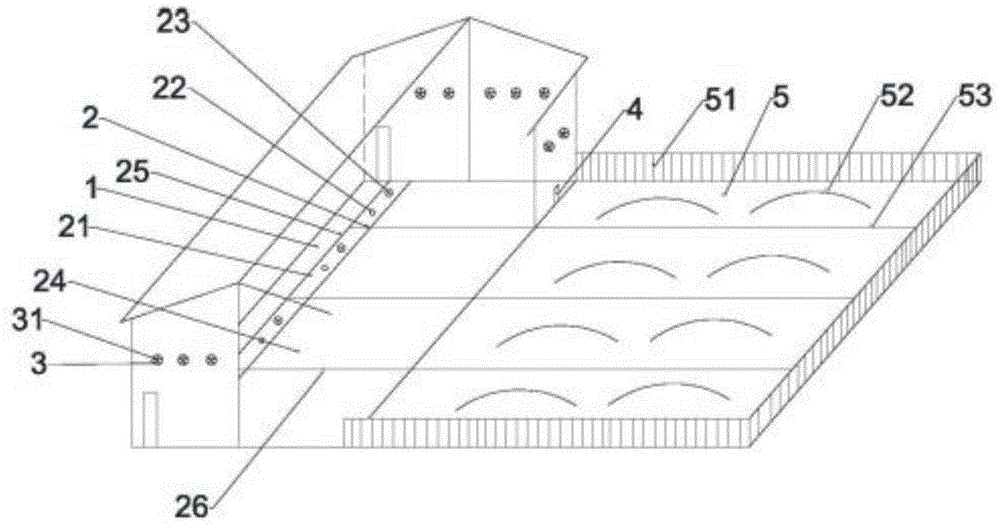Captive-free range segmentally combined swine culture management method
A breeding management and stage technology, which is applied in the field of livestock breeding, can solve the problems of small pork supply, damage to site vegetation, and decline in pork quality, and achieve the effects of sufficient nutrients, accelerated decomposition, and reduced odor
- Summary
- Abstract
- Description
- Claims
- Application Information
AI Technical Summary
Problems solved by technology
Method used
Image
Examples
Embodiment 1
[0036] A method for breeding pigs, comprising:
[0037] At the age of 1 to 135 days, the pigs are raised in the pen-raising area of the pig house, and at the age of 136-180 days, the pigs are raised in the free-range area of the pig house for 6 hours / day, and the rest of the time is raised in the pen-raising area ,in,
[0038] When they were 1 to 35 days old, they were raised according to conventional methods;
[0039] At the age of 36 to 65 days, the automatic feeding machine was used to feed regularly 7 times a day, and fed once a day at 4 o'clock, 8 o'clock, 11 o'clock, 14 o'clock, 17 o'clock, 20 o'clock and 24 o'clock;
[0040] At the age of 66-135 days, the automatic feeding machine was used to feed regularly 6 times / day, and to feed once a day at 4:00, 8:00, 12:00, 16:00, 20:00 and 24:00;
[0041]At the age of 136-180 days, use the automatic feeding machine to feed regularly 6 times / day, feed once a day at 2 o'clock, 8 o'clock, 11 o'clock, 14 o'clock, 17 o'clock an...
Embodiment 2
[0055] A method for breeding pigs, comprising:
[0056] At the age of 1 to 135 days, the pigs are raised in the pen-raising area of the pig house, and at the age of 136-180 days, the pigs are placed in the free-range area of the pig house for 3 hours / day, and the rest of the time is raised in the pen-raising area ,in,
[0057] When they were 1 to 35 days old, they were raised according to conventional methods;
[0058] At the age of 36 to 65 days, the automatic feeding machine was used to feed regularly 7 times a day, and fed once a day at 4 o'clock, 8 o'clock, 11 o'clock, 14 o'clock, 17 o'clock, 20 o'clock and 24 o'clock;
[0059] At the age of 66-135 days, the automatic feeding machine was used to feed regularly 6 times / day, and to feed once a day at 4:00, 8:00, 12:00, 16:00, 20:00 and 24:00;
[0060] At the age of 136-180 days, use the automatic feeding machine to feed regularly 6 times / day, feed once a day at 2 o'clock, 8 o'clock, 11 o'clock, 14 o'clock, 17 o'clock a...
Embodiment 3
[0076] A method for breeding pigs, comprising:
[0077] At the age of 1 to 135 days, the pigs are raised in the pen breeding area of the pig house, and at the age of 136 to 180 days, the pigs are placed in the stocking area of the pig house for 5 hours / day, and the rest of the time is raised in the pen breeding area ,in,
[0078] When they were 1 to 35 days old, they were raised according to conventional methods;
[0079] At the age of 36 to 65 days, the automatic feeding machine was used to feed regularly 7 times a day, and fed once a day at 4 o'clock, 8 o'clock, 11 o'clock, 14 o'clock, 17 o'clock, 20 o'clock and 24 o'clock;
[0080] At the age of 66-135 days, the automatic feeding machine was used to feed regularly 6 times / day, and to feed once a day at 4:00, 8:00, 12:00, 16:00, 20:00 and 24:00;
[0081]At the age of 136-180 days, use the automatic feeding machine to feed regularly 6 times / day, feed once a day at 2 o'clock, 8 o'clock, 11 o'clock, 14 o'clock, 17 o'clock...
PUM
 Login to View More
Login to View More Abstract
Description
Claims
Application Information
 Login to View More
Login to View More - R&D
- Intellectual Property
- Life Sciences
- Materials
- Tech Scout
- Unparalleled Data Quality
- Higher Quality Content
- 60% Fewer Hallucinations
Browse by: Latest US Patents, China's latest patents, Technical Efficacy Thesaurus, Application Domain, Technology Topic, Popular Technical Reports.
© 2025 PatSnap. All rights reserved.Legal|Privacy policy|Modern Slavery Act Transparency Statement|Sitemap|About US| Contact US: help@patsnap.com

